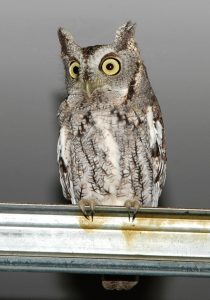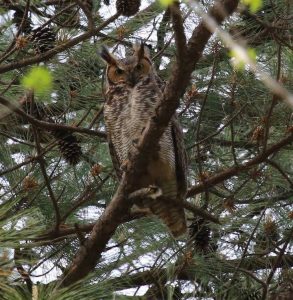By Ashley Peele/Jessy Wilson

Jessy Wilson holding Red-tailed Hawk
The Atlas is a great opportunity to engage students, as well as birders, with wildlife conservation and to provide chances for learning more about bird identification and behavior. To that end, we are encouraging professors and students from around Virginia to consider how they might like to get involved with the VABBA2. This spring, I had the chance to work with Jessy Wilson, a student at Bridgewater College, and her Ornithology professor, Dr. Robyn Puffenbarger. Jessy decided to focus her Ornithology honors project on the Atlas project and we worked up a specific project for her, documenting nocturnal species. She wrote a great article about her experience, so enjoy…
A Student Volunteer’s Experience with the VABBA2
By: Jessy Wilson, Biology Dept., Bridgewater College
My name is Jessy Wilson, and I’m a sophomore undergraduate student at Bridgewater College. I am studying biology with a concentration in wildlife biology. I have loved animals my entire life and I always knew that I wanted to work with them in some capacity. I started getting exposed to wildlife about three years ago by volunteering and later working at the Southwest Virginia Wildlife Center in Roanoke. That was a really important opportunity for me, because it helped me realize my passion for working with wildlife. Out of all the animals that came through the wildlife center, there was a kind that particularly struck me: the birds! I found myself becoming fascinated with everything about them, and I wanted to learn as much as I could. This led me to take the ornithology class offered at Bridgewater this semester, and it has been a fantastic experience that also introduced me to the Virginia Breeding Bird Atlas.

Eastern Screech Owl – Gray Phase (Dick Rowe)
Participating in the Breeding Bird Atlas has not been a part of the structured coursework for my ornithology class; I am in the Honors Program at Bridgewater, and I was looking for a way in which to do some additional work that would enrich my experience in the class. I had never even heard of the atlas project until my professor, Dr. Puffenbarger (Dr. P), mentioned it, and that is what I decided I wanted to be a part of. Working with Dr. P, I have been able to do some nocturnal surveys of the owls in our area that started breeding earlier in the season. Knowing very little about how to survey and not being very familiar with eBird, there was a little bit of a learning curve for me at first. However, after spending some time using eBird, I realized that the process of making checklists and submitting observations and breeding codes was more straightforward than I initially thought. I really enjoyed getting to go out at night and hear Great Horned Owls calling, as well as some Eastern Screech Owls.
The atlas is such a great way to get people involved in monitoring and understanding our bird communities. The inclusive and educatory nature of the project makes it a perfect way to get more participation from students as well, whether they are in organized ornithology classes or just interested in the idea of the atlas project. Based on my experience with the atlas so far, I think that students would vastly contribute to the efforts of the Breeding Bird Atlas. Every Thursday morning, my ornithology class spends a few hours out traveling and practicing field

Great Horned Owl (Rob Bielawski)
identification of birds that we see. In that time, we have observed several species including White-breasted Nuthatches carrying nesting materials. We have even been able to locate a Red-tailed Hawk’s occupied nest, which I submitted into eBird with the appropriate breeding code. Getting more students and ornithology classes involved in data collection would contribute valuable observations to the Atlas!
_______
Thanks to both Jessy and Dr. Puffenbarger for their great work, not only generating data for the Atlas, but also demonstrating the value of student contributions to this project. Conservation can never be successful without dedicated volunteers and partner organizations. Thanks to you all.
-Dr. Ashley Peele, VABBA2 State Coordinator


